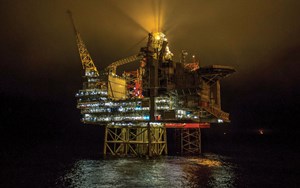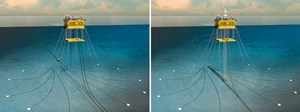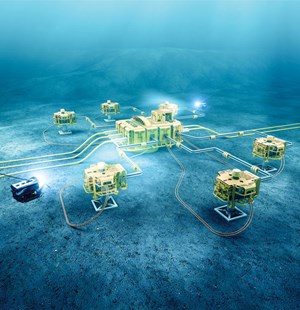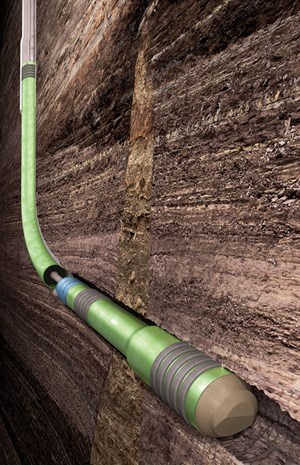Sharper solutions yield relevance on the cutting edge

Offshore companies have honed their processes and technologies to an ever-finer edge over the past few years. In an ugly market, the premium on having the right solution—right now—is paramount. Shattered oil prices have imposed a harsh, new cost perspective on project planning and execution, and driven cutbacks across the board. At the same time, operational challenges have become greater and more complex. Products, services and process are ground ceaselessly against this uncompromising whetstone. The ones that survive, do so on the cutting edge of relevance and applicability.
These solutions, large and small, reach across the full scope of offshore applications, topside, subsea and downhole. They range from dampening the motion of the ocean, to subsea standardization, and downhole tool control. What follows are a few relevant examples.
FPSO IN MOTION
The motion of the ocean is an impediment to riser optimization for floating production, storage and offloading (FPSO) vessels. A Low Motion (LM) design by deepwater engineering firm INTECSEA reduces this dynamic to enable steel catenary risers (SCRs) and top-tensioned risers (TTRs), which are often favored for technical and economic advantages but limited in application, Fig. 1. The vessel design is expected to reduce overall development costs for harsh, remote offshore fields by $500 million to $1.2 billion per project.

While FPSO units have proved to be an effective development solution, extreme heave, roll, and pitch conditions limit the use of SCR wet tree and
TTR dry tree systems, and typically require the use of costly turret system mooring designs.
INTECSEA says their LM design has the advantages of conventional FPSO units without the inherently high motion response. Reducing motion response enables large-diameter SCR applications, and dry TTR applications and well drilling and completions from the floater.
The hull shape allows the use of a conventional spread mooring system and eliminates the need for turret and swivel systems. Improved stability, less sensitivity to weight and vertical center of gravity reduces variations that have historically been one of the highest risk elements to a project’s execution cost and schedule, said INTECSEA. Better motion response also offers improved process safety, helicopter operability, and onboard habitability.
The design features a conventional box-shaped hull with a rectangular cross-section. A free-hanging solid ballast tank (SBT) below the keel is the key to enhancing motion performance. The ballast is hung from short tendons, typically used with tension leg platforms, and is weighted through dedicated compartments using high-density material (concrete, slurry, or iron ore) and seawater. The weighted SBT keeps the tendons in tension, such that the hull and SBT behave as a single unit in dynamic conditions. Their combined mass achieves longer heave, roll and pitch periods, and reduces response to wave frequency.
The LM design is suitable for all water depths, and includes a range of floaters. In addition to the flagship LM-FPSO, LM technology can be used in FLNG applications (LM-FLNG) to improve safety, operability, habitability and economics. A conventional semisubmersible hull with four columns and a ring pontoon can also utilize the LM technology (LM-Semi).
Model testing was performed in collaboration with Korea Research Institute for Ships and Ocean Engineering (KRISO) at their offshore basin in Daejeon, in November 2016. INTECSEA said results of a comprehensive model-testing program showed the motion response of the LM-FPSO was comparable to a TLP and better than a spar.
Performance of the wet tree LM- FPSO was investigated through detailed, time domain analysis. Finite element tendon and SCR models were included in the global model to determine stresses for tender and riser verification. The analysis results compared well with the model test, said INTECSEA. The LM-FPSO design is undergoing certification by DNV.
SUBSEA HARMONY
Steel forgings are essential building blocks for subsea components, but tailor-making them to specific end-users’ requirements is typically a lengthy, expensive step. New guidelines harmonize forging quality management requirements, to enable high quality at reduced delivery times and cost.

A joint industry project (JIP) led by consulting, testing and certification firm, DNV GL, has produced recommended practice (RP), Steel forgings for subsea applications–quality management requirements (DNVGL-RP-B202), Fig. 2. The new guidelines provide a unified approach to the qualification of manufacturers, the manufacturing procedure, and production oversight.
The RP continues a process of subsea standardization by complementing the prior RP, Steel forgings for subsea applications (DNVGL-RP-0034), which harmonizes the technical requirements. Development of the RP in phase two of the JIP involved a confederation of offshore companies, including: Aker Solutions, BP International Limited, Brück, Celsa, Chevron, ConocoPhillips, Det Norske, Dril-Quip, Ellwood Group, Eni, Exxon Mobil, Franchini Acciai, Frisa, GE, OneSubsea, Petrobras, Ringmill, Scana Subsea, Statoil, TechnipFMC, and Total.
The latest RP specifies quality management and surveillance requirements for manufacturing of steel forgings, in accordance with DNVGL-RP-0034. It addresses qualification of forging manufacturers, manufacturing procedure qualification, and surveillance of production. Emphasis is placed on the technical aspects of quality management relevant to forgings, and some particular quality management system (QMS) aspects.
Dr. Brian Newbury of Exxon Mobil, the JIP steering committee chairman, said, “Achieving alignment from the major independent operators to remove direct oversight of critical forgings manufacturing, coupled with vendors’ and forgemasters’ commitment to provide consistent quality oversight across the industry, enables this industry strategy to reduce lead times.”
Subsea technology is the highest-ranked area for emerging technologies R&D in 2017, according to DNV GL’s latest annual benchmark study, Short-term agility, long-term resilience. Standardization efforts to remove complexities are on the rise, according to two-thirds of study respondents.
Statoil Chief Engineer Mons Hauge said, “Standardization is crucial to make subsea solutions even more competitive. We are pleased to see the good results from the joint standardization effort by the oil and gas industry, as Statoil applies this new recommended practice for subsea forging in our future field development.”
Aker Solution’s chief engineer, Elisabeth Hauso Skjerven, noted: “We are dependent on a streamlined supply chain to ensure quality, and to cut cost and delivery time. We therefore welcome standardization initiatives that harmonize customer requirements. Together with the operators, we are now implementing the recommended practices in projects.”
DNV GL leads more than 100 joint industry initiatives. Proposed subsea and well-related JIPs include initiatives to:
- Improve offshore service vessel innovation and integration through better documentation of reliability and operational safety
- Predict the flexible riser annulus environment for better design and fatigue predictions
- Develop guidelines to better assess well intervention blowout risk
- Develop guidelines for decommissioning flexible pipe
- Standardize subsea welding requirements.

EXPANDING OPTIONS
A mono-diameter option to liner and casing design is gaining ground, as Enventure commercializes and broadens its line of SameDrift open-hole expandable technology, Fig. 3. Developed for drilling liners and clad applications, the technology maintains inside diameter when tied back to standard drift casing or used to discretely isolate sections of the wellbore. The pipe is modular and can be used in either type of installation, so it is convenient to pre-position on the rig.
The technology was installed and qualified in a test well during April 2016, followed up by a field trial in November 2016. The current focus is a 12 ¼-in. drift system offered for use below 13 3/8-in. to 14-in. casing. Commercial applications have been scheduled for the middle of this year. Development and testing of an 8 ½-in. system and other sizes is underway, said Enventure.
The single-trip SameDrift process expands the full length of the solid steel tubular, using a proprietary shoe and a unique CLEAR cone expansion technology. Enventure said it is a direct process to drill ahead into the next hole section. Building on the company’s SET technology, the expandable pipe can be rotated and reciprocated while running, to overcome hole irregularities and improve cementing results.
In liner applications, the technology conserves hole size by producing the same drift as the casing string above the expanded liner. With proper planning, multiple liners can be installed end-to-end in a design approach that minimizes or eliminates the telescoping that constrains conventional casing designs. Among the benefits of this mono-diameter capability is the potential for designers to reduce overall hole size and/or extend hole depth, as well as standardize drilling equipment.
The open-hole clad system is used to isolate formation trouble zones without anchoring back into existing casing. It provides the same drift below the previous casing, with lengths from a single joint to over 1,000 ft. Multiple zones can be isolated without reducing the diameter after each clad. For example, when encountering multiple loss zones, the existing drillstring is used to ream the hole below the first clad installation, and the second installation is made through the previous clad, while maintaining the same drift.

TOUGHER UNDEREAMING
Weatherford has stepped up its RipTide drilling reamer offering with a new cutting structure capable of underreaming in highly abrasive formations. The innovation was prompted by recent experiences in deepwater Gulf of Mexico formations like the Wilcox Sands. The reamer features a cutter block design process that incorporates the latest PDC technology, developed in collaboration with PDC provider US Synthetic, Fig. 4. The optimized RipTide reamer features three cutter blocks placed in a balanced, concentric design that minimizes vibration.
The development builds on earlier innovation—the RipTide tool is the industry’s first electronically controlled drilling reamer. The radio frequency identification (RFID) antenna in the tool enables on-demand control for virtually unlimited activation and deactivation. Applications include drilling and enlarging the borehole in a single trip, underreaming below casing restrictions, and eliminating the rathole at total depth.
Results of the collaborative effort include Weatherford’s ReamSync borehole enlargement performance system, which uses predictive cutter and formation interaction software to design the cutter blocks. ReamSync is a three-tiered process that combines dull grading analysis, application-specific cutter block design, and the proprietary Deep Diamond PDC cutters developed by US Synthetic for improved thermal stability.
“By combining our technical expertise with the knowledge of another technology leader in our industry, we are able to innovate with products that deliver maximum value to operators,” said Etienne Roux, V.P. of drilling services at Weatherford.
US Synthetic CEO Rob Galloway observed that, “This project presented a great opportunity for us to collaborate with a service company, to optimize system design for a specific field application. We are pleased with the results of this collaboration. Working closely on specific needs in the field is the key to delivering real value." ![]()
- Coiled tubing drilling’s role in the energy transition (March 2024)
- Advancing offshore decarbonization through electrification of FPSOs (March 2024)
- What's new in production (February 2024)
- Subsea technology- Corrosion monitoring: From failure to success (February 2024)
- Using data to create new completion efficiencies (February 2024)
- Digital tool kit enhances real-time decision-making to improve drilling efficiency and performance (February 2024)
- Applying ultra-deep LWD resistivity technology successfully in a SAGD operation (May 2019)
- Adoption of wireless intelligent completions advances (May 2019)
- Majors double down as takeaway crunch eases (April 2019)
- What’s new in well logging and formation evaluation (April 2019)
- Qualification of a 20,000-psi subsea BOP: A collaborative approach (February 2019)
- ConocoPhillips’ Greg Leveille sees rapid trajectory of technical advancement continuing (February 2019)


